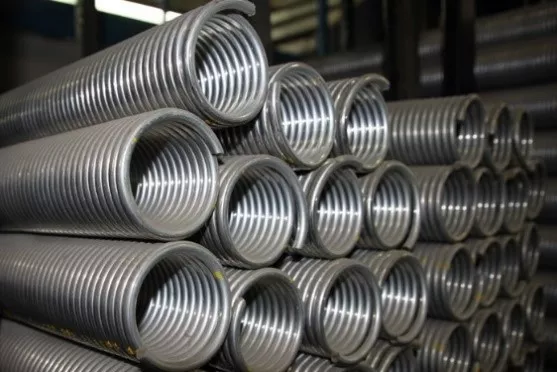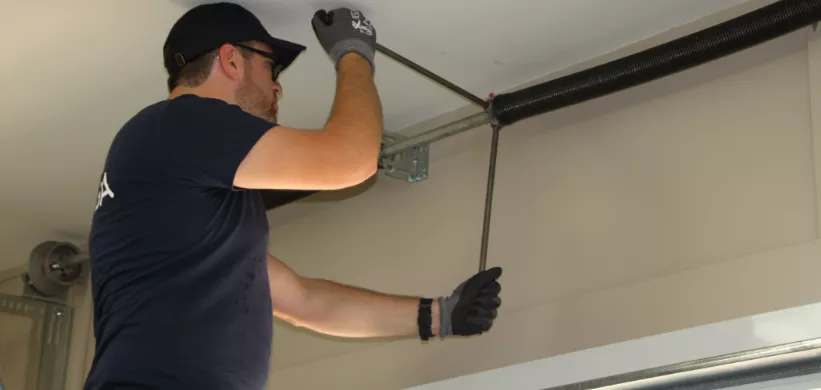If you are in the market for a new garage door, either because you have a new home or your old one is broken, you may be wondering about the spring system. Most people don’t have a whole lot of firsthand knowledge regarding the springs that help open and close their garage doors, and they may not really understand the key differences between the torsion spring systems and the extension spring systems. In this article, we will seek to remedy your lack of knowledge by providing a crash course in torsion springs.
Class is now in session.

Always start with the fundamentals
In regards to the sectional overhead garage doors that are typically installed in residential properties, there are two types of springs. The first type, extension springs, are installed over the horizontal tracks. The second type, torsion springs, are installed over the head of the door.
Torsion springs are by far the more popular option when it comes to opening and closing garage doors for the following reasons:
- Noise: The torsion springs are the quieter option because of the way they are affixed to the wall. They transmit a lot less noise than the extension spring varieties.
- Safety: The torsion spring is fitted inside a shaft which keeps it in place should it ever break. This is very important because a broken spring can cause a lot of damage or even injuries should it break and fly across the garage.
- Operations: The torsion springs are more likely to stay balanced and in good working order. On the other hand, the extension springs often become unbalanced which can cause shuddering, shaking, and a lot of noise.
How things work
Torsion springs can be found in many places besides garage doors, and it is likely that you have come in contact with them in some fashion at multiple times in your life. They are shaped like a coil and the spring works because the twisting of the coil causes it to store mechanical energy. This is what opens your garage door when the open button is pushed or you tug manually on the handle.
The spring system is only one part of the equation
No part of your garage door works independently. The whole team of systems must be in alignment for the door to open as it should. The torsion spring is no exception. How do things come together? Well, in the most basic terms it looks a little bit like bottom bracket + lifting cable + drum + shaft + spring.
In essence, the spring is inserted into a shaft that is mounted to the wall above the garage door via a central plate. That shaft is connected to a grooved drum which, in turn, has a lifting cable wound around it. The cable is also attached to the bottom section of the garage door by a bracket. When the door is closed, the weight of the door produces the mechanical energy in the torsion spring, and when the door is open, the spring is at rest.
Ever wondered how much a garage door actually weighs?
- For a 1 ¾"‑thick steel door, insulated with polyurethane foam: about 2 lb. per square foot (if there are windows, add the weight of each window, about 2 ½ to 3 lb. per window), meaning:
- 9 x 7 ft. = around 150 to 160 lb. (68 to 73 kg)
- 16 x 7 ft. = around 280 to 295 lb. (127 to 135 kg)
- For a 2"‑thick steel door, non‑insulated: about 1 ½ lb. per square foot, meaning:
- 9 x 7 ft. = around 125 to 130 lb. (57 to 59 kg)
- 16 x 7 ft. = around 28 to 295 lb. (102 to 107 kg)
More garage door facts
Our garage door experts field tons of questions each week. We have compiled a few of the most frequently asked questions with their answers below:
-
On a single garage door, is the spring always installed on the left side?
The placement of the spring has no bearing on the functioning of the garage door. Some manufacturers put it on the left and some on the right.
-
Do the garage doors have one or two springs?
In most cases, single doors (often 9 x 7 ft.) have only one spring, and double doors (for example 16 x 7 ft.) have two of them.
-
How long does a spring last?
Garage door parts are generally rated in cycles with one cycle being the opening and closing of the garage door. That being said, the average spring lasts for about 10,000 cycles or four cycles per day for roughly seven years. There are springs in the higher end lines that are rated for 20,000‑25,000 cycles.
-
Are springs galvanized?
On average, springs contain about 35 to 40% galvanization (zinc) to protect against rust. There are fully galvanized options available which are good for those that live in very humid areas of the world.
-
Is there a way to extend the life of a spring?
All of the metal parts in your garage door will be more durable and long‑lasting with regular lubrication and routine maintenance. Check with the manufacturers guide for the recommended maintenance schedule and the recommended lubrications. If you have any questions about these tasks, our garage door technicians are ready to help.
-
How can I tell if my torsion spring is working as it should?
The best way to check out the torsion system is to turn off your electric opener and pull the handle manually. Your garage door should lift with one hand, and you shouldn’t have to strain. The door should feel like it weighs less than 10 pounds. If that is not the case, then you may need to call in the garage door repair experts.
-
Is a torsion spring always placed in front?
No. If the headroom over the door is less than 12" (30 cm), the spring will be mounted in the rear section behind the door. This mounting requires the use of a system of double horizontal tracks.
Broken springs are not DIY projects
It can never be repeated enough, but trying to change a broken torsion spring is extremely dangerous, and it can lead to severe injuries or even death. If you live in or around Saint John, give this task to an expert and contact us now at 1-888-451-4040. We know garage doors from A to Z, and we can repair these parts under high tension. If you’d like, we can send you a quotation by email to help you better budget for garage door repairs.









Add new comment